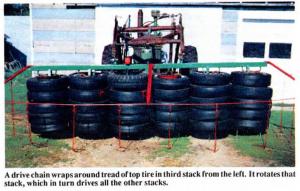1991 - Volume #15, Issue #5, Page #36
[ Sample Stories From This Issue | List of All Stories In This Issue | Print this story
| Read this issue]
Hopper Whopper
 |
"It's a simple, economical way to kill grasshoppers and is a chemical-free alternative to spraying," says Vern Erickson, Fertile, Minn. "As far as I know there's nothing else like it on the market. I built it because I have almost 300 acres in CRP that are infested with grasshoppers. I'm not allowed to cut the grass, but I can run my `hopper whopper' through it. I run the rig just a few inches above the ground, using it early in the season when grasshoppers are young and don't have wings so they can't fly out of the way."
Erickson built his "hopper whopper" by suspending six rows of tires from a 14-ft. long, 4 by 4-in. toolbar that attaches to the front-end loader on his Deere 630 tractor. A pair of brackets welded to the top of the bar fasten with pins to the loader arms.
There are five tires per row. The wheel rims of all five tires in each stack are welded together, and the top rim on each row is bolted to an old car wheel hub. The hub's spindle is welded to the steel bar, allowing each stack of tires to spin freely. An orbit motor mounted on the steel bar and connected to a gearbox (salvaged from the straw spreader off a Deere 65 combine) drives a roller chain that's wrapped around the top tire on the third stack in from one end. This "drive" tire causes all of the other tires to rotate, with each pair of tires turning inward. Chains hanging from a rod out in front of the tires drag through the grass and cause grasshoppers to jump up so they can be caught and crushed by the rotating tires.
Erickson welded all of the rims together, then cut an 8-in. dia. hole in the center of each wheel rim (except for the top wheel in each row which is bolted to the wheel hub). The holes make room for an extension socket wrench that Erickson uses to remove the tire stacks when necessary.
All of the tires are tubeless and non-inflated except for the drive tire which is inflated. Erickson put a tube in it to make sure it would hold up. "The smoother the tires, the better because they can apply more pressure against each other as they rotate," says Erickson. All of the tires are on 14-in. rims. In order to get maximum contact between the two stacks of tires to kill the grasshoppers, Erickson mounted 15-in. tires on all rims except for the bottom one which has a 14-in. tire. "The 15-in. tires ride loosely on the 14-in. rims - the 14-in. tire on the bottom keeps the 15-in. tires above it from working their way down," says Erickson, who used a winch, cable, and a pair of steel bars to pull the two stacks of tires tight against each other while mounting them on the toolbar. The non-inflated 15-in. tires are pulled together enough that the paired-up 14-in. tires on the bottom of the stacks contact each other.
Erickson notes that his tractor has only one hydraulic valve. He uses that to operate the orbit motor so he can't adjust the height of the tires once the orbit motor is hooked up. "I have to set the tires at the height I want them, then block up the loader arms. A tractor equipped with more hydraulic valves would let me adjust height of the tires while they're turning. Also, I can't vary the tires' speed of rotation. I plan to install a car rear end differential and transmission between the orbit motor and gearbox so that I can vary the tires' speed of rotation according to grass conditions."
Contact: FARM SHOW Followup, Vern Erickson, Rt. 1, Box 205, Fertile, Minn. 56540 (ph 218 945-6617).

Click here to download page story appeared in.

Click here to read entire issue
To read the rest of this story, download this issue below or click here to register with your account number.




